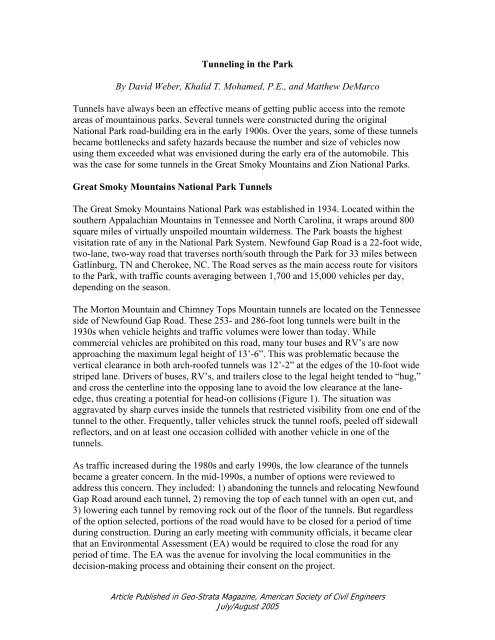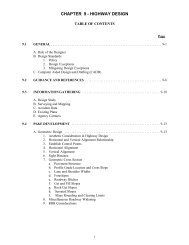Tunneling in the Park By David Weber, Khalid T. Mohamed, P.E. ...
Tunneling in the Park By David Weber, Khalid T. Mohamed, P.E. ...
Tunneling in the Park By David Weber, Khalid T. Mohamed, P.E. ...
You also want an ePaper? Increase the reach of your titles
YUMPU automatically turns print PDFs into web optimized ePapers that Google loves.
<strong>Tunnel<strong>in</strong>g</strong> <strong>in</strong> <strong>the</strong> <strong>Park</strong><strong>By</strong> <strong>David</strong> <strong>Weber</strong>, <strong>Khalid</strong> T. <strong>Mohamed</strong>, P.E., and Mat<strong>the</strong>w DeMarcoTunnels have always been an effective means of gett<strong>in</strong>g public access <strong>in</strong>to <strong>the</strong> remoteareas of mounta<strong>in</strong>ous parks. Several tunnels were constructed dur<strong>in</strong>g <strong>the</strong> orig<strong>in</strong>alNational <strong>Park</strong> road-build<strong>in</strong>g era <strong>in</strong> <strong>the</strong> early 1900s. Over <strong>the</strong> years, some of <strong>the</strong>se tunnelsbecame bottlenecks and safety hazards because <strong>the</strong> number and size of vehicles nowus<strong>in</strong>g <strong>the</strong>m exceeded what was envisioned dur<strong>in</strong>g <strong>the</strong> early era of <strong>the</strong> automobile. Thiswas <strong>the</strong> case for some tunnels <strong>in</strong> <strong>the</strong> Great Smoky Mounta<strong>in</strong>s and Zion National <strong>Park</strong>s.Great Smoky Mounta<strong>in</strong>s National <strong>Park</strong> TunnelsThe Great Smoky Mounta<strong>in</strong>s National <strong>Park</strong> was established <strong>in</strong> 1934. Located with<strong>in</strong> <strong>the</strong>sou<strong>the</strong>rn Appalachian Mounta<strong>in</strong>s <strong>in</strong> Tennessee and North Carol<strong>in</strong>a, it wraps around 800square miles of virtually unspoiled mounta<strong>in</strong> wilderness. The <strong>Park</strong> boasts <strong>the</strong> highestvisitation rate of any <strong>in</strong> <strong>the</strong> National <strong>Park</strong> System. Newfound Gap Road is a 22-foot wide,two-lane, two-way road that traverses north/south through <strong>the</strong> <strong>Park</strong> for 33 miles betweenGatl<strong>in</strong>burg, TN and Cherokee, NC. The Road serves as <strong>the</strong> ma<strong>in</strong> access route for visitorsto <strong>the</strong> <strong>Park</strong>, with traffic counts averag<strong>in</strong>g between 1,700 and 15,000 vehicles per day,depend<strong>in</strong>g on <strong>the</strong> season.The Morton Mounta<strong>in</strong> and Chimney Tops Mounta<strong>in</strong> tunnels are located on <strong>the</strong> Tennesseeside of Newfound Gap Road. These 253- and 286-foot long tunnels were built <strong>in</strong> <strong>the</strong>1930s when vehicle heights and traffic volumes were lower than today. Whilecommercial vehicles are prohibited on this road, many tour buses and RV’s are nowapproach<strong>in</strong>g <strong>the</strong> maximum legal height of 13’-6”. This was problematic because <strong>the</strong>vertical clearance <strong>in</strong> both arch-roofed tunnels was 12’-2” at <strong>the</strong> edges of <strong>the</strong> 10-foot widestriped lane. Drivers of buses, RV’s, and trailers close to <strong>the</strong> legal height tended to “hug,”and cross <strong>the</strong> centerl<strong>in</strong>e <strong>in</strong>to <strong>the</strong> oppos<strong>in</strong>g lane to avoid <strong>the</strong> low clearance at <strong>the</strong> laneedge,thus creat<strong>in</strong>g a potential for head-on collisions (Figure 1). The situation wasaggravated by sharp curves <strong>in</strong>side <strong>the</strong> tunnels that restricted visibility from one end of <strong>the</strong>tunnel to <strong>the</strong> o<strong>the</strong>r. Frequently, taller vehicles struck <strong>the</strong> tunnel roofs, peeled off sidewallreflectors, and on at least one occasion collided with ano<strong>the</strong>r vehicle <strong>in</strong> one of <strong>the</strong>tunnels.As traffic <strong>in</strong>creased dur<strong>in</strong>g <strong>the</strong> 1980s and early 1990s, <strong>the</strong> low clearance of <strong>the</strong> tunnelsbecame a greater concern. In <strong>the</strong> mid-1990s, a number of options were reviewed toaddress this concern. They <strong>in</strong>cluded: 1) abandon<strong>in</strong>g <strong>the</strong> tunnels and relocat<strong>in</strong>g NewfoundGap Road around each tunnel, 2) remov<strong>in</strong>g <strong>the</strong> top of each tunnel with an open cut, and3) lower<strong>in</strong>g each tunnel by remov<strong>in</strong>g rock out of <strong>the</strong> floor of <strong>the</strong> tunnels. But regardlessof <strong>the</strong> option selected, portions of <strong>the</strong> road would have to be closed for a period of timedur<strong>in</strong>g construction. Dur<strong>in</strong>g an early meet<strong>in</strong>g with community officials, it became clearthat an Environmental Assessment (EA) would be required to close <strong>the</strong> road for anyperiod of time. The EA was <strong>the</strong> avenue for <strong>in</strong>volv<strong>in</strong>g <strong>the</strong> local communities <strong>in</strong> <strong>the</strong>decision-mak<strong>in</strong>g process and obta<strong>in</strong><strong>in</strong>g <strong>the</strong>ir consent on <strong>the</strong> project.Article Published <strong>in</strong> Geo-Strata Magaz<strong>in</strong>e, American Society of Civil Eng<strong>in</strong>eersJuly/August 2005
Figure 1. Condition prior to improvements – this is <strong>in</strong>tended to be a two-way highway.Because Newfound Gap Road is <strong>the</strong> primary scenic route that l<strong>in</strong>ks Tennessee and NorthCarol<strong>in</strong>a, and because <strong>the</strong> gateway communities depend on tourism for <strong>the</strong>ir revenue,considerable public opposition mounted to clos<strong>in</strong>g <strong>the</strong> road or detour<strong>in</strong>g traffic around<strong>the</strong> <strong>Park</strong> for socio-economic reasons. To alleviate opposition, a public <strong>in</strong>volvementcampaign was enacted that <strong>in</strong>cluded four public <strong>in</strong>formation meet<strong>in</strong>gs held <strong>in</strong> NorthCarol<strong>in</strong>a and Tennessee.The project team sought new and <strong>in</strong>novative ways to complete construction <strong>in</strong> a timelyfashion and to m<strong>in</strong>imize impacts to <strong>the</strong> natural environment. These <strong>in</strong>cluded:• mill<strong>in</strong>g bedrock along a test section as a potential method for lower<strong>in</strong>g <strong>the</strong>tunnel floor• us<strong>in</strong>g ground penetrat<strong>in</strong>g radar to better evaluate <strong>the</strong> rock quality below<strong>the</strong> tunnel floor• perform<strong>in</strong>g a sample tunnel l<strong>in</strong><strong>in</strong>g <strong>in</strong>stallation to improve dra<strong>in</strong>age beh<strong>in</strong>d<strong>the</strong> l<strong>in</strong><strong>in</strong>g• carry<strong>in</strong>g out a Contractor Market Survey for suggestions <strong>in</strong> reduc<strong>in</strong>g timeand cost• encapsulat<strong>in</strong>g sulfidic material (<strong>the</strong> bedrock is pyrite-bear<strong>in</strong>g and aciddra<strong>in</strong>age from excavated material is a concern)• obta<strong>in</strong><strong>in</strong>g detailed traffic counts for a six month period <strong>in</strong> conjunction withtraffic model<strong>in</strong>g to determ<strong>in</strong>e potential traffic impacts dur<strong>in</strong>g construction.In addition, <strong>the</strong> Newfound Gap Road corridor has been nom<strong>in</strong>ated for <strong>the</strong> NationalRegister of Historic Places. The tunnel portals, stone guardwalls, and scenic vistas arecontribut<strong>in</strong>g elements to this nom<strong>in</strong>ation. Throughout <strong>the</strong> project development process,<strong>the</strong> project team sought out a large number of partnerships with community andregulatory agencies. FHWA signed a Memorandum of Agreement with <strong>the</strong> State HistoricArticle Published <strong>in</strong> Geo-Strata Magaz<strong>in</strong>e, American Society of Civil Eng<strong>in</strong>eersJuly/August 2005
Figure 2. F<strong>in</strong>ished Morton Mounta<strong>in</strong> tunnel with lowered grade and new approach wallsto match historic masonry.Zion National <strong>Park</strong> TunnelsTunnels with<strong>in</strong> Zion National <strong>Park</strong>, <strong>in</strong> sou<strong>the</strong>rn Utah, experienced similar safety issues tothose tunnels <strong>in</strong> <strong>the</strong> Great Smoky Mounta<strong>in</strong>s National <strong>Park</strong>. The Mount Carmel tunnel(5,600-feet long) and <strong>the</strong> East “Short” Tunnel (490-feet long) were constructed withconventional drill and blast methods <strong>in</strong> <strong>the</strong> 1920s and had s<strong>in</strong>ce become safety hazardsfor <strong>the</strong> large recreational vehicles try<strong>in</strong>g to pass through. The FHWA and NPS completedwiden<strong>in</strong>g of <strong>the</strong> shorter, East Tunnel as an <strong>in</strong>itial phase of improvement. A roadheaderwas used to excavate <strong>the</strong> sandstone tunnel walls (Figure 3). Enlargement of <strong>the</strong> tunnelwas restricted to nighttime hours dur<strong>in</strong>g w<strong>in</strong>ter to reduce impact on <strong>the</strong> travel<strong>in</strong>g public.The lack of handcrafted and historic portal structures – and <strong>the</strong> softer rock – made thiswiden<strong>in</strong>g project considerably less complex than <strong>the</strong> Great Smoky Mounta<strong>in</strong>s project.The Mount Carmel tunnel is more spectacular and longer than <strong>the</strong> tunnel widened byroadheader. It was constructed through Navajo sandstone very near <strong>the</strong> canyon wall andhas several open galleries to <strong>the</strong> canyon, orig<strong>in</strong>ally used as construction access. Verticaljo<strong>in</strong>t<strong>in</strong>g <strong>in</strong> <strong>the</strong> Navajo sandstone has led to numerous collapses along canyon walls with<strong>in</strong><strong>the</strong> park and at <strong>the</strong> tunnel. Figure 4 shows <strong>the</strong> view west along <strong>the</strong> canyon wall fromGallery 3, where <strong>in</strong> 1958 a canyon wall collapse occurred. The collapse caused a localtunnel failure and exposed tunnel l<strong>in</strong><strong>in</strong>g (most of <strong>the</strong> tunnel is unl<strong>in</strong>ed) as seen <strong>in</strong> <strong>the</strong>figure. In this more critical geologic sett<strong>in</strong>g, work is proceed<strong>in</strong>g more slowly here than itdid for <strong>the</strong> East Tunnel. At this time we have begun evaluat<strong>in</strong>g <strong>the</strong> feasibility of ei<strong>the</strong>rwiden<strong>in</strong>g <strong>the</strong> orig<strong>in</strong>al tunnel or construct<strong>in</strong>g a new one. Seismic reflection tomographywas used to map large rock fractures immediate to <strong>the</strong> exist<strong>in</strong>g tunnel and <strong>in</strong> <strong>the</strong> pillar ofrock between <strong>the</strong> tunnel and <strong>the</strong> near-vertical canyon wall. The technique satisfied <strong>the</strong>criteria of speed and low impact, us<strong>in</strong>g a sledgehammer as an energy source andgeophones affixed to <strong>the</strong> tunnel walls, but provided more limited <strong>in</strong>formation on rockquality beyond tunnel walls than anticipated.Article Published <strong>in</strong> Geo-Strata Magaz<strong>in</strong>e, American Society of Civil Eng<strong>in</strong>eersJuly/August 2005
Figure 3. Road header used at Zion National <strong>Park</strong> for conventional tunnel widen<strong>in</strong>g.Figure 4. Column collapse at Gallery 3, Mt. Carmel tunnel, Zion National <strong>Park</strong>.OverviewNeeds for roadways with<strong>in</strong> our National <strong>Park</strong>s evolve and conditions change. Tunnels arean effective means of provid<strong>in</strong>g public access, but <strong>the</strong>ir adaptation to chang<strong>in</strong>g needs canbe challeng<strong>in</strong>g. Innovative <strong>in</strong>vestigation, design, and construction techniques must beutilized to m<strong>in</strong>imize impacts to <strong>the</strong> natural, historic, cultural, and socio-economicresources of <strong>the</strong> <strong>Park</strong>s and surround<strong>in</strong>g communities. As <strong>the</strong>se tunnel projectsdemonstrate, early <strong>in</strong>volvement by <strong>the</strong> gateway communities dur<strong>in</strong>g <strong>the</strong> projectdevelopment process is critical to <strong>the</strong>ir success, especially projects that impact <strong>the</strong>travel<strong>in</strong>g public.<strong>David</strong> <strong>Weber</strong> is a project manager <strong>in</strong> <strong>the</strong> Eastern Federal Lands Highway Division of <strong>the</strong>Federal Highway Adm<strong>in</strong>istration (FHWA), located <strong>in</strong> Sterl<strong>in</strong>g, VA. He was responsiblefor <strong>the</strong> project development of <strong>the</strong> tunnels <strong>in</strong> <strong>the</strong> Great Smoky Mounta<strong>in</strong>s. He can bereached at Dave.<strong>Weber</strong>@fhwa.dot.gov.<strong>Khalid</strong> T. <strong>Mohamed</strong>, P.E., is <strong>the</strong> supervisory geotechnical eng<strong>in</strong>eer for <strong>the</strong> EasternFederal Lands Highway Division of <strong>the</strong> Federal Highway Adm<strong>in</strong>istration. He is located<strong>in</strong> Sterl<strong>in</strong>g, VA and is responsible for delivery of geotechnical services for roadwayprojects <strong>in</strong> or provid<strong>in</strong>g access to national parks, forests, and o<strong>the</strong>r federal lands <strong>in</strong> <strong>the</strong>eastern states. He can be reached at khalid.mohamed@fhwa.dot.gov.Mat<strong>the</strong>w DeMarco is <strong>the</strong> supervisory geotechnical eng<strong>in</strong>eer for <strong>the</strong> Central FederalLands Highway Division of <strong>the</strong> Federal Highway Adm<strong>in</strong>istration. Based <strong>in</strong> Lakewood,CO, he is responsible for delivery of geotechnical services for roadway projects <strong>in</strong> orArticle Published <strong>in</strong> Geo-Strata Magaz<strong>in</strong>e, American Society of Civil Eng<strong>in</strong>eersJuly/August 2005
provid<strong>in</strong>g access to national parks, forests, and o<strong>the</strong>r federal lands <strong>in</strong> <strong>the</strong> central andsouthwestern states. He can be reached at mat<strong>the</strong>w.demarco@fhwa.dot.gov.Article Published <strong>in</strong> Geo-Strata Magaz<strong>in</strong>e, American Society of Civil Eng<strong>in</strong>eersJuly/August 2005
















